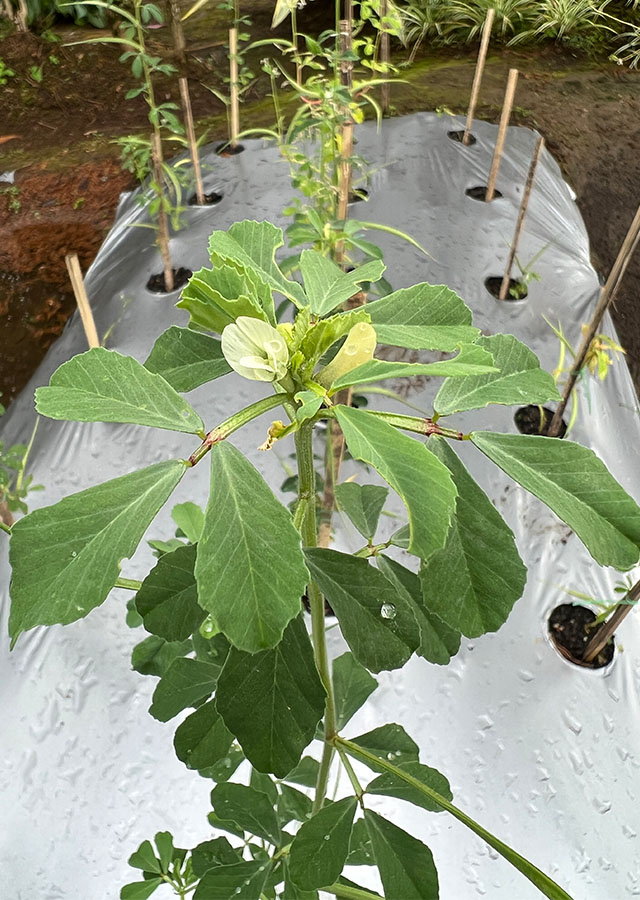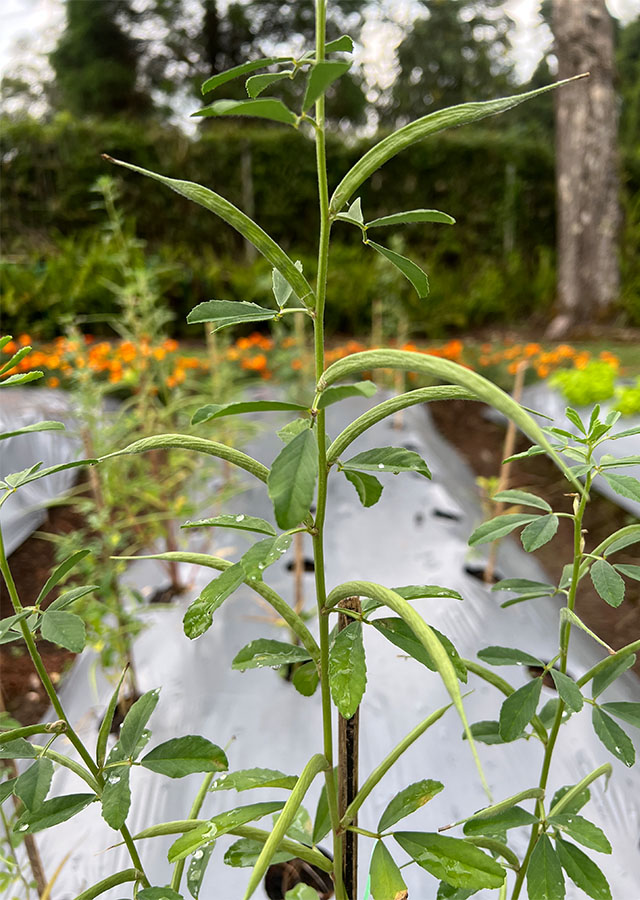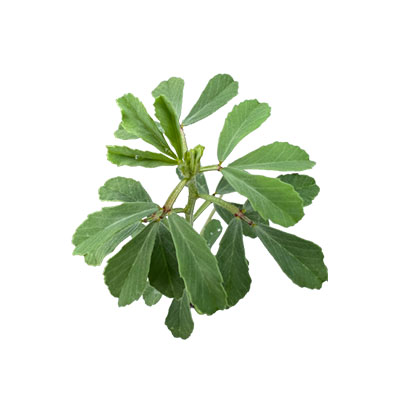Fenugreek
Trigonella foenum-graecum L.
Fabaceae
Location in our garden
Vegetable



Synonym
Buceras foenum-graecum (L.) All.
Foenum-graecum sativum Medik.
Trigonella ensifera Trautv.
Habitus
Herbaceous. An erect, stiff, strongly scented, annual herb, growing about 40-80 cm tall.
Part Used
Leaves
Seeds
Growing Requirements
Full Sunshine
Drought Resistant
Low Temperature
Habitat
Grassland
Overview
T. foenum-graecum is probably indigenous to the eastern Mediterranean, western Asia and India, but its natural distribution is hard to ascertain as it has been cultivated since antiquity, the first written record dating back as far as 4000 BC. Its cultivation spread to China, Ethiopia, Europe, the southern parts of the former Soviet Union and throughout the Arab world. In Europe and North America it is now grown on a small scale only. It has been tried successfully in Java (Indonesia), but is currently not grown in South-East Asia. A fairly common food, condiment and medicinal plant, it is widely cultivated for its edible seed. The oil has potential for use in cosmetics and perfumery. The crushed seed, mixed with oil and massaged into the scalp, is recommended for glossy hair. An infusion of the seed, used as a skin lotion, and a yellow dye is obtained from the seed.
Vernacular Names
Fenugrec (French), Halba (Malay), Penantazi (Burmese), Hồ lô ba (Vietnamese).
Agroecology
Fenugreek occurs in field verges, uncultivated ground, dry grasslands and hillsides. It is suitable for areas with moderate or low rainfall (500-700 mm per year) and is a sun-loving crop. It is fairly drought resistant. In warm climates it is usually grown as a cool season crop, while in temperate areas it is grown as a summer crop. Even where the winter is rather severe, it may be sown under cover in autumn, in this way tolerating frost to -15 °C. Fenugreek prefers well-drained fertile loams or sandy loams, but grows fairly well on gravelly and sandy soils. It is not adapted to heavy clay soils. Moderately saline soils are tolerated, but not acid soils. The acceptable pH range is 5.8-8.2.
Morphology
- Root - taproot well-developed and roots much branched.
- Stem - solitary or basally branched, terete, slightly pubescent, green to purple.
- Leaves - alternate, trifoliolate; stipules triangular, small, adnate to the petiole; petiole grooved above, 1-4(-6) cm long; rachis short; leaflets obovate or oblong, 1.5-4 cm × 0.5-2 cm, upper part of margin denticulate.
- Flowers - solitary, axillary, subsessile, 12-15 mm long; calyx campanulate, finely pubescent, tube 4.5 mm long, lobes 5, 2 mm long; standard hood-shaped, obovate, 11-15 mm × 6-7 mm, clawed, pale yellow; wings obovate, 12 mm × 2.5 mm, clawed, auriculate, pale yellow; keel ladle-shaped, 7 mm × 2 mm, clawed, entirely split dorsally, ventrally split near the base, bi-auriculate, pale yellow to white; stamens diadelphous (9 + 1); pistil with sessile ovary, glabrous style and capitate stigma.
- Fruit - a straight to occasionally sickle-shaped, linear pod, 5-19 cm × 0.2-0.4 cm, glabrous, with fine longitudinal veins, slightly bulging over the 10-20 seeds; beak 2-3 cm long.
- Seed - oblong-rhomboidal, 3-5 mm × 2-3 mm, with a deep furrow dividing it into two unequal lobes, with rounded corners, rather smooth, brownish.
Cultivation
- Generatively propagated by seed.
- Pre-soak the seed for 12 hours in warm water and then sow in situ.
- Seed is sown 1-2 cm deep at a distance of 7.5 cm within the row and 20-45 cm between rows.
- Germination of fenugreek takes 4-5 days.
Chemical Constituents
Quinone, flavones, flavonoids (quercetin), phenolic compounds (coumarin, scopoletin, chlorogenic acid, caffeic acid, and p-coumaric acid), tannins, terpenes and terpenoids (sabinene, 3-carene, menthol, α-pinene, β-pinene, β-terpineol, cineol, anethol, β-terpinyl acetate, carvone,1-p-menthen-8-yl acetate, 1-pentanol,1-hexanol,2-methyl-2-butene-1-ol, 2-methyl-2-butenal,2-pentylfuran, formic acid, propanoic acid, γ-butyrolacetone, 5-alkylated γ-lactones, 3-amino-4,5-dimethyl-2(3H)-furanone), lactones, saponin diosgenin, alkaloids (trigonelline, gentianine, carpaine), steroidal (choline), amino acids (4-hydroxyisoleucine, arginine), galactomanin, and polypeptides.
Traditional Medicinal Uses
- The seed and leaves are anticholesterolemic, anti-inflammatory, antitumor, carminative, demulcent, deobstruent, emollient, expectorant, febrifuge, galactagogue, hypoglycaemic, laxative, parasiticide, restorative and uterine tonic. It is useful in the treatment of inflammation and ulcers of the stomach and intestines.
- The seed is very nourishing and body-building and is one of the most efficacious tonics in cases of physical debility caused by anaemia or by infectious diseases, especially where a nervous factor is involved, in the treatment of late-onset diabetes, poor digestion (especially in convalescence), insufficient lactation, pful mainenstruation, labour pains etc. The seeds freshen bad breath and restore a dulled sense of taste.
- Externally, the seeds can be ground into a powder and used as a poultice for abscesses, boils, ulcers, burns etc, or they can be used as a douche for excessive vaginal discharge.
- Compounds extracted from the plant have shown cardiotonic, hypoglycaemic, diuretic, antiphlogistic and hypotensive activity, and has shown potential for use in cancer therapy.
Part Used
Reference Sources
- Fern, Ken. (2021). Useful Tropical Plants: Trigonella foenum-graecum. https://tropical.theferns.info/viewtropical.php?id=Trigonella+foenum-graecum. 06-03-2022.
- Kew Royal Botanic Gardens. (No date).Trigonella foenum-graecum L. https://powo.science.kew.org/taxon/urn:lsid:ipni.org:names:523957-1. 06-03-2022.
- Ritika. (2016). Trigonella foenum-graecum L.: A REVIEW OF ITS ETHNOBOTANY, PHARMACOLOGY AND PHYTOCHEMISTRY. International Journal of Advance Research in Science and Engineering, 5(9): 192-204.
- Tawan, C.S., and Wulijarni-Soetjipto, N. (2019). Trigonella foenum-graecum (PROSEA). https://uses.plantnet-project.org/en/Trigonella_foenum-graecum_(PROSEA). 06-03-2022.

